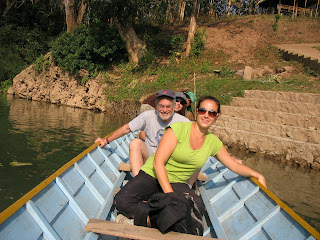
One morning while in Vientiane, the capital of Laos, I saw a flyer, advertising an art exhibit by or about handicapped persons. It appeared to be in walking distance, so I headed over to it. I went a bit off course and must have looked perplexed when a woman my age came by on her motorcycle and asked where I was going. She said she was a doctor and had time to take me there between meetings.
It turned out to be a campus of sorts where wheelchairs and prosthetic arms, legs, hands, and feet are crafted. There was also a gymnasium specifically for wheelchair sports. One single story building with a loft inside was the headquarters of COPE an organization that makes prosthetics - half of which go to people missing limbs blown off by bombs. There might be as many as 300 new victims a year in Laos - most of them hurt by cluster bombs they call "bombies". So who's bombing Laos? It was the U.S. throughout a secret campaign of nine years (1964 - '73) during our war against Viet Nam. It's estimated that 30% of the 260 million+ bombs that we dropped on Laos did not go off at the time. Most of these are cluster bombs and pineapple bombs, small enough to pick up in one hand. Filled with ball bearings that rip a body apart, they are designed to hurt people, not tanks or buildings. Dozens are released from a cannister as it falls to the ground and spread themselves over a wide area. Many end up just under the ground, only to be set off when a farmer hoes a rice field or a person digs a posthole for their home.
In Xienghuang province, where I'd just been, (the 2nd most heavily bombed area), there are posters and even songs in the schools instructing kids not to pick up the little yellow metal balls. It's not just the kids who need to be warned. With the price of scrap metal going up in recent years, many poor Laotians have looked for bomb scraps to redeem for money. There's been a big business in the kind of metal detectors you see people swinging in an arc along the sand at public beaches in the States. Besides the little bombies, we dropped 4 million king-size bombs and consequently there's a lot of scrap metal waiting to be harvested by entrepreneurial risk-takers.
Since 1994 there have been bomb clearing squads who painstakingly clear the land and have safely destroyed about a half million of them. That would leave about 77 million left to go. The U.S. has offered to send additional clearing teams, but the Lao government has turned down the offer. My understanding is that they would appreciate more funding to develop their own teams. So far our government has contributed $20 million over the 15 years since the clearing started. One and a third million a year is the kind of bonus that many of the VP's and CEO's in our infamous financial sector received annually.
The COPE building does house a very moving exhibit. It includes a life-size model of a typical dwelling you'd find in a Lao village and it is filled with metal hooks, pots, and bowls that have been fashioned from bomb fragments. There is a photo exhibit and narrative of a father who went fishing with his two sons and found a cluster bomb. He'd heard that you could catch many fish if you throw a cluster bomb against the water. Needless to say limbs were torn from his body as his experiment blew up. Fortunately his sons were behind a tree. The exhibit included a shelf full of defused bombs. It was disconcerting to find out from the COPE Coordinator, Jo Pereira, that many similar bombs on display shelves in restaurants, guesthouses, and travel agencies throughout the town of Phon Sa Van - where I'd stayed a few days - have not been defused. Some still contain white phosphorous.
At first there was a very young Lao woman who guided me through the various exhibits. It's overwhelming to view the photographs (none are graphic), the bombs, etc. without feeling deeply connected to it as an American. My guide was very kind and there were no anti-U.S. messages in the exhibit. But when you are surrounded by this painful reality that we never think of at home and that has been part of Laotian life these past 45+ years, it's impossible not to tear up.
Jo, the Project Coordinator, made some coffee and talked about her work. She's an expat from Britain committed to repairing bodies with prosthetics - one person at a time. With every new arm or leg an individual receives, a whole family is put "on its feet" again. Since it began in 1995, COPE has restored mobility to over 9,000 people.
At this point there are just a handful of countries that have not agreed to end the manufacture and use of cluster bombs. Jo was proud to have testified with some Lao friends just before Britain decided to sign. Still holding out are the U.S., Israel, India, and China. Listening to President Obama - in his first address to Congress - mention so many things that he would turn around from the very dark years of the Bush-Cheney administration, there is hope that this terrible business of cluster bombs will finally end in the U.S. and go the way of Guantanamo, Abu Ghraib, and torture.
more information:COPE www.copelaos.org
COPE parent org. - www.powerinternational.org
UXO LAO - www.uxolao.gov.la
United Nations Development Lao - www.undplao.org

Bombs on display in Phon Sa Van




























